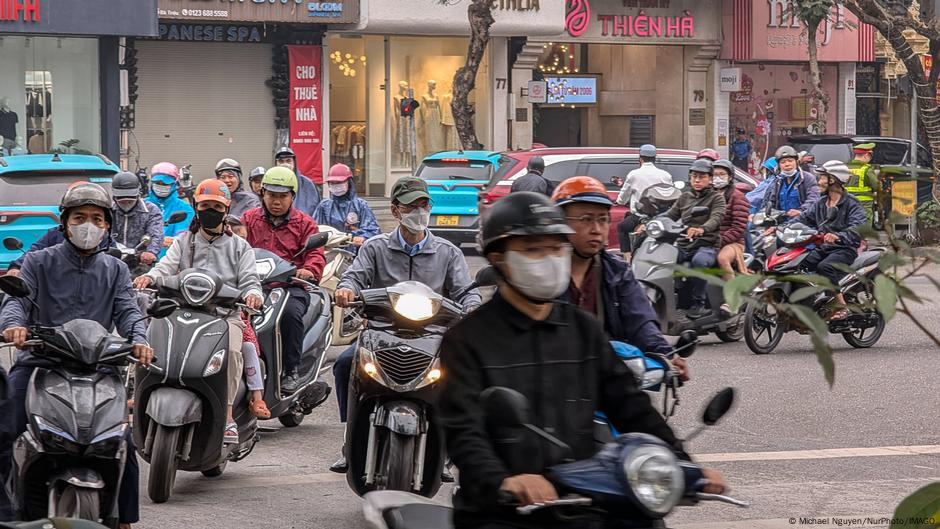
Vietnam Embarks on Ambitious Plan to Electrify its Motorbike Fleet
Vietnam is on the cusp of a significant transportation shift, aiming to replace millions of gasoline-powered motorbikes with electric alternatives. This ambitious endeavor has the potential to reshape Vietnamese cities, its economy, and the daily lives of its citizens.
Phasing Out Gasoline Motorbikes: A Timeline
The government is actively pursuing a strategy to transition the country's vast population of approximately 80 million motorcyclists from gasoline-powered vehicles to electric two-wheelers in the coming years.
A key initiative was announced in July, with Prime Minister Pham Minh Chinh declaring a ban on gasoline-powered motorcycles within Hanoi's Ring Road 1, a 7-kilometer (4.3-mile) route encircling the city center, by mid-2026.
This measure could affect up to two million daily commuters in the capital, which was recently identified as one of the world's most polluted major cities.
Authorities intend to expand the ban to Ring Road 2 by 2028 and Ring Road 3 by 2030, alongside implementing new restrictions on gasoline-powered cars.
Ho Chi Minh City is also considering a similar policy, with plans to phase out 400,000 gasoline-powered ride-hailing motorbikes from the city center by early 2026, with a complete phase-out targeted for the end of 2028.
Nationwide, the Ministry of Transport has set a goal for electric vehicles to account for 30% of cars and 22% of motorbikes by the end of the decade.
Dual Motivations: Environment and Industry
Analysts suggest that the government's push for electric motorbikes is driven by both environmental concerns and industrial development priorities.
Air pollution is a pressing issue in Vietnamese cities, particularly Hanoi. The government aims to address this problem and demonstrate its commitment to environmental protection.
Furthermore, the bans would support the growth of large private sector conglomerates like VinFast and Pega, which are already prominent players in Vietnam's rapidly expanding electric motorbike market.
The Heavy Toll of Air Pollution
Air pollution poses a significant threat to public health in Vietnam. The World Health Organization (WHO) estimates that it causes at least 70,000 deaths annually, making it the country's second-leading cause of death after cancer.
Earlier this year, Hanoi was labeled as the "world's most polluted metropolis" by the air-quality monitoring group IQAir.
Hazardous PM2.5 particle levels have been measured at more than 24 times higher than WHO guidelines, leading to school and factory closures.
A study conducted by Hanoi's National Economics University in 2020 estimated that pollution costs the Vietnamese economy between €8.5 billion ($10 billion) and €11 billion, equivalent to approximately 5% of the country's GDP that year.
Public Opinion and Practical Concerns
Public sentiment regarding the motorcycle ban is varied. Some support the ban due to growing concerns about air pollution in Hanoi.
However, others view the policy as being implemented too quickly, particularly for informal sector workers who depend on gasoline-powered motorbikes for their livelihoods.
Millions of drivers face the prospect of replacing their motorbikes within a short timeframe. Even the most affordable electric models cost around €380, a considerable expense in a country where the average monthly income is approximately €250.
Additional concerns exist regarding the limited availability of charging stations and the capacity of Vietnam's power grid to handle the increased demand.
Vietnamese Brands Poised for Growth
Vietnam is already a leader in electric motorcycle usage in Southeast Asia, ranking third globally behind China and India.
In 2022, electric bikes accounted for 12% of all motorcycles in Vietnam, an increase from 5.4% in 2019, and this share continues to rise.
The ruling Communist Party has announced reforms that designate the private sector as the primary driver of economic growth, promising support for "national champions" like VinFast.
Sales of small electric bikes surged by 113% in the first five months of 2025, while sales of larger models increased by 49%.
This growth benefits local brands, as Japanese giant Honda, which controls 80% of Vietnam's conventional motorcycle market, has a negligible share of the electric segment. Vietnamese manufacturers VinFast and Pega account for approximately 70% of e-motorbike sales.
VinFast, the country's first global automotive exporter, led the market in 2021 with a 43.4% market share, followed by Pega with 15%.
VinFast has experienced a sales surge of nearly 500% in early 2025, and has reduced prices by up to 20% since May. Pega remains competitive in the mid- to low-cost segment.
Honda has announced pilot rental schemes, but has not yet committed to mass production of electric two-wheelers in Vietnam.
Potential Challenges and Uncertainties
The implementation of the ban remains uncertain.
The Vietnam Association of Motorcycle Manufacturers, an industry body primarily composed of foreign manufacturers, believes that the transition is happening too rapidly.
The industry body has recommended a phased approach, starting with restrictions on older, high-emission motorbikes and vehicles used for commercial purposes, while exempting personal vehicles.
The association argues that the ban could lead to significant job losses if implemented too quickly, and warns that sales of gasoline-powered motorbikes could decline sharply for foreign businesses.
Delays are possible, as the government has previously adjusted ambitious policies when implementation proved challenging. Any adjustments would likely be presented as practical adaptations rather than failures.

No comments:
Post a Comment